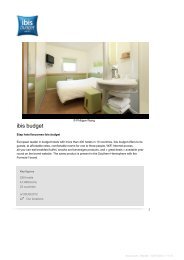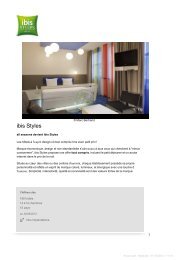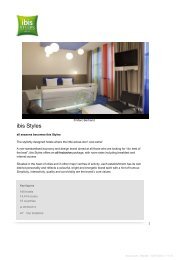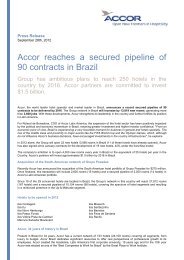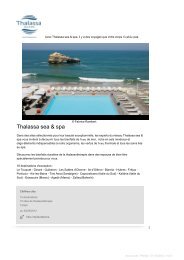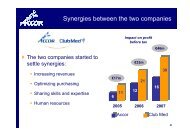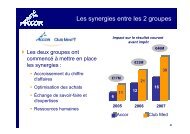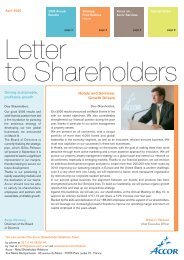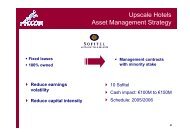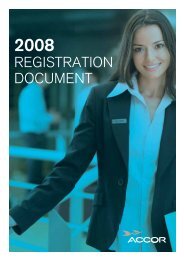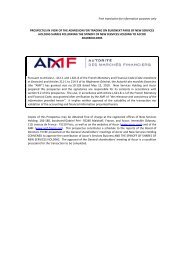Environmental Reporting - Protocol
Environmental Reporting - Protocol
Environmental Reporting - Protocol
You also want an ePaper? Increase the reach of your titles
YUMPU automatically turns print PDFs into web optimized ePapers that Google loves.
<strong>Environmental</strong> <strong>Reporting</strong> - <strong>Protocol</strong><br />
Contents<br />
Contents<br />
I. ENVIRONMENTAL REPORTING AT ACCOR ................................................................................................... 2<br />
I.1. REPORTING GOALS AND CONTENT.......................................................................................................................... 2<br />
I.2. REPORTING PROCEDURES ....................................................................................................................................... 3<br />
I.2.1. <strong>Reporting</strong> period & scope of coverage ......................................................................................................... 3<br />
I.2.2. Overall reporting structure and responsibilities .......................................................................................... 3<br />
I.2.3. <strong>Reporting</strong> systems ......................................................................................................................................... 3<br />
II. WATER AND ENERGY INDICATORS .............................................................................................................. 4<br />
II.1. DEFINITIONS .......................................................................................................................................................... 4<br />
II.1.1. Energy consumption..................................................................................................................................... 4<br />
II.1.2. Water consumption ...................................................................................................................................... 5<br />
II.2. REPORTING PROCEDURE......................................................................................................................................... 5<br />
II.2.1. Period ............................................................................................................................................................ 5<br />
II.2.2. Scope ............................................................................................................................................................. 5<br />
II.2.3. Roles and responsibilities ............................................................................................................................. 6<br />
II.2.4. Structure and timetable ................................................................................................................................ 7<br />
II.2.5. Data collection and checking ....................................................................................................................... 8<br />
II.2.6. Internal verification of Water and Energy data ........................................................................................ 10<br />
II.2.7. Estimation/adjustment of missing/incorrect data ...................................................................................... 12<br />
II.2.8. Validation of estimated data by Regional Managers ................................................................................. 13<br />
II.2.9. Percentage of data estimated...................................................................................................................... 13<br />
III. ENVIRONMENTAL CHARTER INDICATORS ............................................................................................. 14<br />
III.1. DEFINITION ...................................................................................................................................................... 14<br />
III.2. REPORTING PROCEDURE................................................................................................................................... 14<br />
III.2.1. Period and scope ..................................................................................................................................... 14<br />
III.2.2. Roles and responsibilities ....................................................................................................................... 14<br />
III.2.3. Structure and timetable .......................................................................................................................... 15<br />
III.2.4. Data collection and checking ................................................................................................................. 15<br />
IV. APPENDIX 1 - CONSOLIDATED WATER AND ENERGY INDICATORS ................................................ 17<br />
V. APPENDIX 2 – REPORTING FOR LENÔTRE ............................................................................................... 19<br />
V.1. INDICATORS ......................................................................................................................................................... 19<br />
V.2. REPORTING PERIOD AND SCOPE ............................................................................................................................ 19<br />
V.3. STRUCTURE AND TIMETABLE ............................................................................................................................... 19<br />
Updated: 15 November 2010 Page 1 / 19
I. ENVIRONMENTAL REPORTING AT ACCOR<br />
I.1. REPORTING GOALS AND CONTENT<br />
<strong>Environmental</strong> reporting is intended to quantify key environmental indicators, and addresses twin goals:<br />
1. To measure the effectiveness of the ECO (environmental) aspects of the Earth Guest social and<br />
environmental responsibility programme. In 2005, Accor set itself a series of result-based targets to<br />
be achieved by 2010. The environmental indicators used enable the Group to measure the<br />
improvements in its performance and the deployment of the initiatives introduced to achieve these<br />
results.<br />
2. To provide transparent communication regarding the environmental footprint imposed by Accor<br />
operations, the actions implemented to reduce that footprint and the trend in the Group‟s<br />
environmental performance. As a listed French company, this target complies with a legal<br />
obligation (Article 116 of Law 2001-420 of 15 May 2001 enacted by Decree 2002-221).<br />
The reporting protocol sets out the environmental indicators, data collection and consolidation methods, as<br />
well as the data checks applied. This protocol must be applied by all those involved in the reporting<br />
process, regardless of whether they work in hotels, country management teams or central services<br />
teams, in order to guarantee that the values used for management and external communication are accurate<br />
and comprehensive.<br />
Accor uses 2 major categories of indicator:<br />
Water consumption, energy consumption and greenhouse gas emissions control indicators<br />
<strong>Environmental</strong> Charter and <strong>Environmental</strong> Management indicators<br />
WARNING: For the purposes of environmental reporting, it may be necessary to estimate hotel water and/or<br />
energy consumption where data are unavailable or incorrect. These estimates will help to ensure that we do<br />
not underestimate the total amounts of water and energy used by the Group. Nevertheless, the ratios used<br />
to monitor consumption trends (e.g.: energy consumption per available room) must be calculated only on<br />
the basis of actual data and must not include estimates.<br />
Updated: 15 November 2010 Page 2 / 19
I.2. REPORTING PROCEDURES<br />
I.2.1. <strong>Reporting</strong> period & scope of coverage<br />
The data for the reporting period and scope of coverage are very specific to the water/energy consumption<br />
and Charter indicators, and are addressed in those sections devoted to each category of indicator.<br />
The data for determining the scope covered by the reporting process originate in the MEGA reference base,<br />
which is the Group reference source for identifying which hotels fall within the scope and for the following<br />
hotel-related data (zone/country/region, brand, number of rooms operated, operating method, status,<br />
operational and publication management structure: Executive Chief Operating Officer (Pôle) / Chief Operating<br />
Officer (DGO) / Managing Director (DGR) / Director of Operations (DOP) and Publication unit.<br />
The main body of this document applies to hotels. Lenôtre operations are addressed in appendix.<br />
I.2.2. Overall reporting structure and responsibilities<br />
The key stages for water/energy consumption and Charter reporting are as follows:<br />
PREPARATION FOR REPORTING<br />
LAUNCH OF REPORTING<br />
DATA COLLECTION &<br />
CONSOLIDATION<br />
CHECKING AND ESTIMATION<br />
OF DATA<br />
VALIDATION<br />
FINAL CONSOLIDATION<br />
Water & Energy indicators<br />
& <strong>Environmental</strong> Charter indicators<br />
Water & Energy indicators<br />
only<br />
The Charter and water/energy consumption reporting processes involve 3 levels of contributor:<br />
- the Group <strong>Reporting</strong> Manager<br />
- the Region/Country <strong>Reporting</strong> Managers<br />
- the Hotel <strong>Reporting</strong> Managers<br />
Their responsibilities are indicator-specific, and are addressed in the corresponding sections.<br />
I.2.3. <strong>Reporting</strong> systems<br />
<strong>Environmental</strong> Management System (OPEN)<br />
OPEN is the official system used by Accor hotels for environmental management.<br />
It has been designed to:<br />
- achieve the twin goals of environmental reporting and management<br />
- be as simple and effective as possible to use<br />
The OPEN application contains 4 management modules:<br />
- The <strong>Environmental</strong> Charter<br />
- Water and energy consumption<br />
- The “Plant for the planet” programme<br />
- Waste management<br />
OPEN can be accessed via the Group intranet<br />
Access rights and system development are the responsibility of:<br />
- the DDTS for the "Water & Energy" module<br />
- the Sustainable Development Department for the other modules<br />
Updated: 15 November 2010 Page 3 / 19
II. WATER AND ENERGY INDICATORS<br />
II.1. DEFINITIONS<br />
II.1.1. Energy consumption<br />
DEFINITION<br />
This term refers to the total quantity of energy consumed annually by Accor hotels, regardless of the source<br />
of energy (electricity, heating fluids, district heating networks, etc.) and how it is used (rooms division,<br />
kitchens, etc.). The energy covered by this indicator is the final amount of energy consumed by the hotel.<br />
Transmission and distribution system losses are not included.<br />
Total energy consumption is expressed in MWh. Fuel energy must be calculated on the basis of Net Calorific<br />
Value (NCV).<br />
This indicator must be reported to the Group for each energy type.<br />
Inclusion of energy from renewable sources<br />
Green electricity and electricity from renewable sources are included in the total energy consumption figure.<br />
Solar heating generated and consumed by those hotels fitted with thermal solar panels is not included in their<br />
total energy consumption figure.<br />
Other exclusions<br />
It excludes energy consumed as a result of using vehicles owned or leased by Accor, and that consumed<br />
during refurbishment works.<br />
METHODOLOGY<br />
MASS - ENERGY CONVERSION<br />
Net Calorific Value (NCV) refers to the heat released as a result of burning natural gas or fuel oil.<br />
NCV varies relative to the water content and grade of the fuel used (Gross Calorific Value (GCV) is<br />
independent of water content). It is therefore strongly recommended that conversions use the specific<br />
NCV for the type of fuel used. The following NCVs may be used where actual values are missing.<br />
NATURAL GAS = 47.7 MJ / kg<br />
HEAVY FUEL OIL = 38.6 MJ / kg<br />
DOMESTIC HEATING OIL = 41.4 MJ / kg<br />
VOLUME - MASS CONVERSION<br />
The process of monitoring gas energy consumption is based directly on the quantities (kg) of gas consumed.<br />
It is often the volume of gas used which is monitored at hotel level. Gas density is the basis for converting<br />
volume (m3) to quantity (kg).<br />
Please note: Gas density varies according to pressure and temperature.<br />
The following example applies to methane (which accounts for more than 90% of natural gas):<br />
(P = 1.013 bar / T = - 161.6°C) Density = 1.813 kg/m3 (Boiling point)<br />
(P = 1.013 bar / T = 0°C) Density = 0.73 kg/m3 (“Normal” conditions)<br />
(P = 1.013 bar / T = 15°C) Density = 0.68 kg/m3 (“Standard” conditions)<br />
(P = 1.013 bar / T = 21°C) Density = 0.55 kg/m3 (Specific volumes)<br />
P= Pressure / T = Temperature<br />
SAMPLE CALCULATION<br />
The hotel consumes 6,000 m3 of natural gas (Pressure = 1.013 bar and Temperature = 15°C)<br />
This corresponds to 4080 kg of gas (6000x0.68) or 194640 MJ (4080x47.7) or 700610 kWh (194640x3.6)<br />
Updated: 15 November 2010 Page 4 / 19
II.1.2. Water consumption<br />
DEFINITION<br />
This refers to the quantities of water consumed by hotels over the period of one year, regardless of use<br />
(kitchens, garden watering, etc.).<br />
Water consumption does not include:<br />
- water pumped by the hotel's own installations from underground or surface water courses<br />
- water consumed as part of refurbishment works<br />
- water resulting from the recycling of rainwater or wastewater<br />
The reporting unit used is the cubic metre (m 3 )<br />
II.2. REPORTING PROCEDURE<br />
II.2.1. Period<br />
<strong>Reporting</strong> is an annual process, and covers the period from 1 January to 31 December of the current financial<br />
year. An exception is done for Accor North America, with a reporting period from 1 December to 30<br />
November.<br />
II.2.2. Scope<br />
The scope of reference covers all Accor owned and managed operating units at 31 December. Those hotels<br />
that have changed ownership structure or brand during the year are included on the basis of their ownership<br />
structure /brand at 31 December of the current year.<br />
The following are included:<br />
- The operations of subcontractors on hotel premises (housekeeping teams, gardeners, etc.)<br />
The following are excluded:<br />
- The Group's national and regional head offices<br />
- Vehicle fleets leased by Accor<br />
- Services offered by the hotel, but not managed by Accor (e.g.: shops, hair salon, etc.)<br />
- Hotel refurbishment<br />
Updated: 15 November 2010 Page 5 / 19
II.2.3. Roles and responsibilities<br />
Roles and responsibilities exist at 3 levels of the organisational structure: central, country/region and hotel.<br />
WATER & ENERGY REPORTING MANAGER - CORPORATE<br />
- Defines the Accor Water & Energy data reporting methods<br />
- Provides overall management of Water & Energy reporting at Accor level<br />
- Consolidates and checks data comprehensiveness and data values at Group level<br />
- Calculates estimated data, where required<br />
WATER & ENERGY REPORTING MANAGER - COUNTRY/REGION<br />
- Manages Water & Energy reporting for his/her region/country<br />
- Consolidates and checks orders of magnitude for zone data<br />
- Forwards data to the Accor Water & Energy <strong>Reporting</strong> Manager within the deadlines set<br />
- Checks the estimated data produced by the Accor Water & Energy <strong>Reporting</strong> Manager for the hotels in<br />
his/her zone<br />
WATER & ENERGY REPORTING MANAGER - HOTEL<br />
- Collects data for his/her hotel<br />
-Checks the comprehensiveness of data for his/her hotel<br />
- Forwards data to the Country/Regional Water & Energy <strong>Reporting</strong> Manager within the deadlines set<br />
A “Country/Region Water & Energy Report” sheet sets out the reporting specifics for each region/country<br />
reporting entity in terms of water and energy reporting organisation, data collection, reporting system and data<br />
checking.<br />
Updated: 15 November 2010 Page 6 / 19
II.2.4. Structure and timetable<br />
The reporting key stages and timetable are shown in the following diagram.<br />
Preparation for reporting<br />
END 30 OCT<br />
WHO Accor O&E <strong>Reporting</strong> Manager<br />
- <strong>Protocol</strong> issued to the Regional Water & Energy <strong>Reporting</strong> Managers<br />
- Country/region reporting sheets issued for completion and signature<br />
- Regional managers notified of the Water & Energy reporting schedule<br />
- Issue of an Excel data collection file for those hotels not deployed with OPEN<br />
WHO Regional O&E <strong>Reporting</strong> Managers<br />
- Familiarisation with the protocol and distribution of the necessary information to<br />
service providers and/or hotels<br />
- Completion and signature of the country/region sheet, followed by forwarding to<br />
the Accor O&E <strong>Reporting</strong> Manager<br />
WHO Hotels / Service Providers<br />
- Familiarisation with the information required at their level<br />
Launch of reporting<br />
WHO Accor O&E <strong>Reporting</strong> Manager<br />
- <strong>Reporting</strong> launch e-mail<br />
WHO Regional O&E <strong>Reporting</strong> Managers<br />
- Information of service providers and/or hotels<br />
END 20 DEC<br />
Data Collection & Consolidation<br />
END 25 JAN<br />
WHO Hotels / Service Providers<br />
- Collection of hotel source data and forwarding to the Regional O&E <strong>Reporting</strong><br />
Manager<br />
WHO Regional O&E <strong>Reporting</strong> Managers<br />
- Monitoring of data uploaded for the reporting scope<br />
- Verification of orders of magnitude for the data received (comparison with<br />
previous year, with financial data, etc.)<br />
- Consolidation and forwarding to the Accor O&E <strong>Reporting</strong> Manager<br />
WHO Accor O&E <strong>Reporting</strong> Manager<br />
- Monitoring to ensure the comprehensiveness of data for the reporting scope<br />
- Monitoring of data uploading to ensure that the deadline is met<br />
- Consolidation of regional data<br />
Updated: 15 November 2010 Page 7 / 19
Data checking and estimation<br />
WHO Accor O&E <strong>Reporting</strong> Manager<br />
- Checking of data and submission of estimated values to Regional O&E <strong>Reporting</strong><br />
Managers (where values cannot be validated)<br />
Validation of estimated data<br />
WHO Regional O&E <strong>Reporting</strong> Manager<br />
END 2 FEB<br />
- Validation by Regional O&E <strong>Reporting</strong> Managers of data estimated by the Accor<br />
O&E Manager<br />
Final consolidation<br />
WHO Accor O&E <strong>Reporting</strong> Manager<br />
END 15 FEB<br />
- Final consolidation of collected and estimated data by the Accor O&E Manager<br />
II.2.5. Data collection and checking<br />
II.2.5.1. Data collection at hotel level<br />
END 25 FEB<br />
The data collection methods are listed in descending order of preference:<br />
1<br />
Meter readings<br />
Readings for all the hotel's supplies meters are entered into the hotel monitoring system in<br />
accordance with a regional timetable.<br />
Special case: where 2 hotels share the same water / energy meter:<br />
Based on the total water/energy consumption of both hotels, estimation of the quantity consumed<br />
by each hotel pro-rata of the following data:<br />
-Room nights or rented rooms (in order of preference) for water consumption<br />
-Available rooms for energy consumption.<br />
1.1<br />
Automated readings<br />
Where the appropriate meters are fitted, it is possible to use special systems (remote meter<br />
reading systems using telephone lines, building management systems (BMS), etc.) to automate<br />
the meter reading process and transfer the readings to information systems (databases). Where<br />
automated readings are used, the source data must be output from the reading system and<br />
transmitted automatically to OPEN or imported into the appropriate system.<br />
1.2<br />
Manual readings<br />
This involves the periodic reading of supplies meters and the calculation of consumption by<br />
comparing the readings for 31 December of the current year (N) with those for 1 January of the<br />
same year.<br />
Updated: 15 November 2010 Page 8 / 19
2<br />
Collection of data from suppliers<br />
The supplier communicates the source data values in a file containing details of:<br />
- the quantities consumed by each hotel during the year (or the value for each of the 12 months<br />
of the year)<br />
- the associated unit<br />
- other invoicing-related data (e.g. invoice amounts, dates, etc.)<br />
- product-specific data (e.g.: gas characteristics)<br />
3<br />
Data calculated from supplier invoices<br />
Supplier invoices may show the consumption value over a defined period. The source data value<br />
can then be read from the invoice(s) for the year.<br />
Special case: Where the invoicing period does not cover the entire year, the source data value<br />
must be corrected pro-rata of the number of days covered.<br />
For stored fluids: Where liquefied gases (LNG, propane, etc.) and domestic heating oil are<br />
stored on site, consumption can be calculated by adding together the quantities shown on the<br />
invoices/delivery notes, corrected to reflect the stock positions at 1 January and 31 December of<br />
the current year (N).<br />
4<br />
Estimation<br />
If none of the methods shown above is feasible, then the value is estimated by the Accor O&E<br />
<strong>Reporting</strong> Manager and validated by the Regional O&E <strong>Reporting</strong> Manager concerned. However,<br />
it is crucial that the reference "NA" appears next to the appropriate entry wherever the data<br />
concerned has not been obtained using one methods shown above.<br />
Hotel operations data (number of available rooms, number of rented rooms and number of room nights) are<br />
held in the Datawarehouse 1 – Grand Back reporting (the Group reference source for hotel operations data<br />
for a given financial year, including the number of available rooms and the number of rented rooms).<br />
Water and energy consumption data are collected and consolidated using the systems described below,<br />
which are listed in order of preference.<br />
1<br />
2<br />
The OPEN Water & Energy Module<br />
The Water & Energy module of the OPEN system:<br />
− Collects source data at hotel level<br />
− Consolidates collected data at each operational management level<br />
− Calculates consumption ratios (water consumption on the basis of rented rooms or room<br />
nights, and energy consumption on the basis of available rooms)<br />
The use of this module for entering and consolidating data is strongly advised.<br />
Updated: 15 November 2010 Page 9 / 19<br />
Excel<br />
Hotels not included in the OPEN deployment may use Excel or any other similar application<br />
deployed locally to collect their data.<br />
The Regional/Country <strong>Reporting</strong> Manager then consolidates the data (for those of his/her hotels<br />
without OPEN) into an Excel file using the format supplied by the Accor O&E Manager.<br />
1 Financial information system management and data input processes are not covered or explained in this document. The<br />
entities concerned will be able to provide details in response to any request for further information.
II.2.6. Internal verification of Water and Energy data<br />
Data are subject to a series of checks to ensure that they are comprehensive and accurate. Central checks<br />
are applied by the Property Management Department. The actions to be taken by this department and by<br />
each country on completion of these checks are shown in the following diagram.<br />
No response within 8<br />
days<br />
Integration of the<br />
estimated data<br />
CHECK -<br />
Data estimation or<br />
adjustment by Accor<br />
O&E <strong>Reporting</strong><br />
Manager.<br />
Ask the Country O&E<br />
Manager for the<br />
validation of the<br />
estimated / adjusted<br />
data<br />
Validation of the<br />
estimated data<br />
Integration of the<br />
estimated data<br />
Communication of a<br />
new corrected data<br />
providing a positive<br />
check result<br />
New country data<br />
imported<br />
Data retained<br />
Updated: 15 November 2010 Page 10 / 19<br />
Check<br />
Explanation of the<br />
negative check result<br />
for the data tested<br />
Data retained<br />
CHECK +
II.2.6.1. Checking data comprehensiveness<br />
THE ACCOR PROPERTY MANAGEMENT DEPARTMENT: The systematic checks applied centrally are shown in the<br />
following diagram.<br />
1<br />
1.1<br />
Comprehensiveness of hotel data<br />
Verification source: MEGA<br />
Data required: status at 31 December in current year (N)<br />
- Hotel code: Hxxxx<br />
- Country & organisation (Executive Chief Operating Officer (Pôle) / Chief Operating Officer (DGO) /<br />
Managing Director (DGR) / Director of Operations (DOP))<br />
- Hotel name<br />
- Ownership structure<br />
Checking principle: The aim is to use the list of all hotels at 31 December to identify those hotels<br />
categorised as "No submission" or "No data/entry"<br />
Processing of checking results: Where corrections are made, the reason is given as "lack of data"<br />
1.2<br />
CONTROL OF DATA COMPREHENSIVENESS (CORPORATE)<br />
FROM PREVIOUS YEAR (N-1)<br />
Comprehensiveness of resources data<br />
Data required: Resources data for the previous year (N-1), with hotel code<br />
Checking principle: The aim is to compare the data for years N & N-1 for each resource in order to identify<br />
those hotels with N-1 data but no N data for each resource<br />
Processing of checking results: Where corrections are made, the reason is given as "lack of N-1 data"<br />
FROM THE OPERATING ACCOUNT (OA)<br />
Data required: N allocation data with hotel code and OA line allocation (OA455 to OA459).<br />
Checking principle: The aim is to compare the year N and OA data for each resource in order to identify<br />
those hotels with an accounting allocation and zero consumption data<br />
Processing of checking results: Where corrections are made, the reason is given as "lack of accounting<br />
data"<br />
1.3<br />
Comprehensiveness of monthly data<br />
Checking principle: To identify missing months (where data transmission is monthly).<br />
Processing of checking results: Where corrections are made, the reason is given as "lack of data for x<br />
months", where x is the number of months with no data. N.B.: always look at the hotel opening date<br />
REGION/COUNTRY WATER AND ENERGY REPORTING MANAGERS: Monthly checking of data at country level to<br />
ensure that it is comprehensive is highly recommended.<br />
Updated: 15 November 2010 Page 11 / 19
II.2.6.2. Checking data values<br />
THE ACCOR PROPERTY MANAGEMENT DEPARTMENT: The systematic checks applied centrally are shown in the<br />
following diagram.<br />
2<br />
2.1<br />
CHECKING DATA VALUES<br />
Plausibility<br />
Data required: No data required other than consumption data<br />
Checking principle: Check that the consumption ratios fall in the range 5 to 200 kWh per available room<br />
for energy, and 50 to 2,000 litres per rented room for water.<br />
Processing of checking results: Where corrections are made, the reason is given as "order of magnitude"<br />
2.2<br />
DATA FOR PREVIOUS YEAR (N-1)<br />
Consistency<br />
Data required: Water and energy consumption ratios for the previous year (N-1)<br />
Checking principle: Check that the variances between ratios for years N and N-1 are below 20%.<br />
Processing of checking results: Where corrections are made, the reason is given as "N-1 consistency"<br />
UNIT COSTS<br />
Data required: Accounting data for the cost of each energy type.<br />
Checking principle: Calculate the average prices of each hotel supply (water, electricity, fuel oil, water,<br />
etc.), and compare these prices with the average for the country. The check is negative where the<br />
variance is greater than 20%.<br />
Processing of checking results: Where corrections are made, the reason is given as "cost"<br />
REGION/COUNTRY WATER AND ENERGY REPORTING MANAGERS : Country-level application of the following data<br />
accuracy checks is highly recommended:<br />
- Plausibility check<br />
- Consistency check relative to data for the previous year (N-1)<br />
II.2.7. Estimation/adjustment of missing/incorrect data<br />
In the absence of data at hotel level or where data are identified as incorrect as a result of checking, the data<br />
value will be estimated or adjusted by the Accor Water & Energy <strong>Reporting</strong> Manager:<br />
- Data is described as adjusted where the element of estimation applies to less than 20% of the total<br />
value (e.g.: one month‟s data is missing)<br />
- Data is described as estimated in all other cases<br />
There are two possible estimation methods. They can be applied either to annual data or monthly data.<br />
1. For water and energy consumption by type (electricity, fuel oil, gas, etc.), estimation is based on<br />
historic data (previous year: N-1). These data are corrected pro-rata of occupancy statistics. For<br />
example, where water is concerned, any historic data (previous year: N-1) available is extrapolated<br />
pro-rata of the number of room nights. Any clarifications required will be appended to the consolidated<br />
data.<br />
2. In the absence of historic data, water and energy consumption estimates will be based on data for<br />
comparable hotels (same brand, same region and similar size) pro-rata of occupancy data or<br />
averages for the brand, where the country has no comparable hotels against which to benchmark.<br />
Updated: 15 November 2010 Page 12 / 19
N.B. Hotels that have been the subject of partial closure (e.g. for refurbishment) during the year remain inside<br />
the scope of report publication. Their consumption data are then adjusted or estimated on the basis of historic<br />
data.<br />
II.2.8. Validation of estimated data by Regional Managers<br />
Data estimated by the Accor Energy & Water <strong>Reporting</strong> Manager are submitted to the Regional O&E<br />
<strong>Reporting</strong> Managers. The Regional O&E Managers must respond in writing within 8 days to say whether<br />
they approve these estimates or whether they wish to retain the original data. Their decision must be<br />
supported by explanation. In case there is no response within 8 days, the estimated data is considered as<br />
validated.<br />
II.2.9. Percentage of data estimated<br />
On completion of these actions, the Accor O&E Manager finalises the indicator values and indicates:<br />
- The percentage of estimated data and the breakdown between the various reasons for estimation<br />
(“lack of data”, “lack of accounting data”, “order of magnitude”, etc.).<br />
- The percentage of adjusted data and the breakdown between the various reasons for adjustment<br />
(“lack of data”, “lack of accounting data”, “order of magnitude”, etc.).<br />
Updated: 15 November 2010 Page 13 / 19
III. ENVIRONMENTAL CHARTER INDICATORS<br />
III.1. DEFINITION<br />
The Accor Hotels <strong>Environmental</strong> Charter sets out a list of 65 actions (cf.<br />
http://www.accor.com/fr/developpement-durable/actions-transverses.html) designed to deliver practical<br />
improvements to hotel environmental performance. The <strong>Environmental</strong> Guide (available via accor.com)<br />
explains the environmental benefits of each action, its implementation and the criteria that must be met if the<br />
action is to be considered as correctly applied by the hotel.<br />
The <strong>Environmental</strong> Charter indicators are used to track the percentage of hotels actually implementing each<br />
action as a function of the total number of hotels that could potentially implement that action.<br />
Calculations<br />
METHODOLOGY<br />
All the indicators used to track an action defined in the charter are calculated in the same way:<br />
The result is expressed as a percentage.<br />
III.2. REPORTING PROCEDURE<br />
III.2.1. Period and scope<br />
Number of hotels implementing the action [X]<br />
Number of hotels able to implement the action [X]<br />
The consolidation scope for <strong>Environmental</strong> Charter indicators includes all owned, managed and franchised<br />
hotels.<br />
The environmental charter results are consolidated at the end of November in the reporting year concerned.<br />
III.2.2. Roles and responsibilities<br />
Roles and responsibilities exist at 3 levels of the organisational structure: central, country/region and hotel.<br />
Updated: 15 November 2010 Page 14 / 19
III.2.3. Structure and timetable<br />
Preparation for reporting<br />
WHO<br />
Launch of Group reporting<br />
WHO<br />
Launch of regional reporting<br />
WHO<br />
Data collection<br />
WHO<br />
Consolidation<br />
WHO<br />
Accor <strong>Environmental</strong> <strong>Reporting</strong> Manager<br />
- <strong>Protocol</strong> issued to Regional Charter <strong>Reporting</strong> Managers<br />
- Charter reporting schedule issued<br />
Accor <strong>Environmental</strong> <strong>Reporting</strong> Manager<br />
- e-mail notification and reporting opened in OPEN<br />
- Excel files sent to those hotels with no access to OPEN<br />
- <strong>Reporting</strong> progress monitored in OPEN<br />
Regional Charter <strong>Reporting</strong> Manager<br />
- e-mail notification<br />
- Excel files sent to those hotels with no access to OPEN<br />
- <strong>Reporting</strong> progress monitored in OPEN<br />
Hotel <strong>Reporting</strong> Manager<br />
- Importing of hotel Excel files<br />
- <strong>Reporting</strong> closed in OPEN<br />
END 30 OCT<br />
END 10 NOV<br />
END 15 NOV<br />
END 15 DEC<br />
- Completion of the Charter module in OPEN or in Excel for those hotels<br />
with no access to OPEN<br />
Accor <strong>Environmental</strong> <strong>Reporting</strong> Manager<br />
III.2.4. Data collection and checking<br />
END 15 JAN<br />
Data are consolidated using the <strong>Environmental</strong> Charter module of the OPEN system. Only those hotels that<br />
cannot access the Accor intranet should use Excel files. These files are gathered on a regional basis and<br />
forwarded to the Group <strong>Environmental</strong> <strong>Reporting</strong> Manager. These files are then automatically imported into<br />
the OPEN system. The <strong>Environmental</strong> Charter data are therefore processed entirely within the OPEN system.<br />
III.2.4.1. Internal verification of data<br />
Prior to entering the relevant data, the person responsible for collecting the data must check that the<br />
Charter actions have actually been implemented. In making this check, he/she should refer to the<br />
“Validation” section of the Hotels <strong>Environmental</strong> Charter Guide.<br />
The hotel general manager must check all the data entered, paying special attention to new actions.<br />
Updated: 15 November 2010 Page 15 / 19
III.2.4.2. External verification of data<br />
The hotel quality audits cover the 8 <strong>Environmental</strong> Charter actions included in the Accor sustainable<br />
development targets for 2010:<br />
Use low energy lamps for permanent lighting<br />
Install water flow regulators on taps (in bedroom bathrooms)<br />
Install water flow regulators on showers<br />
Recycle paper/cardboard packaging<br />
Recycle waste paper, newspapers and magazines<br />
Recycle glass packaging<br />
Safe disposal of the hotel used batteries<br />
Safe disposal of low energy lighting tubes and bulbs<br />
The internal audit process also makes the following check at hotel regional head office level: “The regional<br />
head office has identified those Hotels <strong>Environmental</strong> Charter actions to be implemented as a priority by the<br />
hotels in its region, assists hotels in implementing those actions and monitors the improvement in hotel results<br />
relative to these priority actions”.<br />
Updated: 15 November 2010 Page 16 / 19
IV. APPENDIX 1 - CONSOLIDATED WATER AND ENERGY<br />
INDICATORS<br />
This appendix refers to those water and energy indicators whose (Group-level) values are calculated centrally.<br />
Their definition is therefore less critical for hotel managers.<br />
Analysing the year-on-year trend for some indicators requires the same hotels to be monitored over the<br />
period between the current reporting year “N” and a reference year “N-P” (where P = the number of years<br />
prior to the current year. e.g.: if N=2010 and P=3, then N-P=2007). The “scope of comparability” refers to the<br />
point at which the reporting scopes for years “N-P” and “N” intersect.<br />
Hotels present in “N-P” may leave the “scope of comparability” for the following reasons: closure (total or<br />
partial) / disposal / change of ownership structure (e.g.: an owned hotel which becomes a managed hotel).<br />
Hotels that were not present in year N-P, but which have acquired and/or opened by year N are not included<br />
in the scope of comparability.<br />
ADDITIONAL ENERGY-RELATED INDICATORS<br />
Breakdown of energy consumption: This indicator refers to the percentage of total energy consumption<br />
represented by each type of energy. These percentages are effectively the ratios between the consumption<br />
value for each type of energy (electricity, natural gas, fuel oil, etc.) and the value for total energy<br />
consumption.<br />
Energy consumption per available room: This is the ratio between total energy consumption (all<br />
consumption values added together) for all Group sites (excluding Accor Sea & Spa and Lenôtre) and the<br />
total number of available rooms (all rooms added together). Estimated consumption values are not used<br />
when calculating this ratio.<br />
ADDITIONAL WATER-RELATED INDICATORS<br />
Water consumption per rented room: This is the ratio between total water consumption (all consumption<br />
values added together) for all hotel sites (excluding Accor Sea & Spa and Lenôtre) and the total number of<br />
rooms rented during the year (all rooms added together). Estimated consumption values are not used when<br />
calculating this ratio. N.B.: the ratio monitored by the Group will eventually be calculated on the basis of room<br />
nights. The rented room ratio has been retained for this purpose, because it was the ratio used in 2005 when<br />
setting the Group‟s 10% reduction target for the 2010 deadline.<br />
THERMAL SOLAR ENERGY GENERATION<br />
DEFINITION<br />
This refers to the solar heating generated by owned, managed and franchised hotels fitted with solar panels<br />
used to heat the domestic hot water supply. This type of generation does not include photovoltaic solar<br />
energy.<br />
The reporting unit used is the kilowatt hour (kWh).<br />
METHODOLOGY<br />
For each hotel, the term „solar energy generation‟ refers to:<br />
- the amount of thermal solar energy generated, as measured for the period between 1 January and<br />
31 December of the year concerned. This on-site measurement requires the installation of meters<br />
specific to the solar heating installation. This solution is recommended by the Group, as it enables<br />
installation operation to be monitored<br />
- an estimated level of generation, where accurate measurement of generation is not available. Where<br />
this is the case, the solar heating value is arrived at by multiplying the overall area of solar panels (in<br />
m2) by an average productivity figure of 500 kWh per m2 per year<br />
Updated: 15 November 2010 Page 17 / 19
GREENHOUSE GAS EMISSIONS<br />
DEFINITION<br />
These are greenhouse gas emissions resulting from the consumption of energy by hotel operations. These<br />
emissions do not include those resulting from:<br />
- leakage of refrigerant gases from hotel installations<br />
- employee travel (including those using company/service vehicles)<br />
- deliveries of products and services to hotels<br />
The reporting unit used is the Tonne Equivalent CO2 (teq CO2)<br />
METHODOLOGY<br />
Direct greenhouse gas emissions are calculated on the basis of:<br />
- hotel consumption of energy from fuel used on the premises (natural gas, fuel oil, etc.)<br />
- the greenhouse gas emission factors for these fuels: these factors are those contained in the GHG<br />
<strong>Protocol</strong> (Stationary Combustion version 3[1].1). The greenhouse gas emission factors for CH4<br />
(methane) and N2O (nitrous oxide) are taken from Group I of the IPCC report for 2007, and cover a time<br />
horizon of 100 years.<br />
Indirect greenhouse gas emissions are calculated on the basis of:<br />
- consumption of electricity and heat from district heating networks, broken down by country<br />
- the greenhouse gas emission factors for national power generation and district heating networks set out<br />
in http://www.ghgprotocol.org/ - IEA, CO2 Emissions from Fuel Combustion, 2009 edition)<br />
Updated: 15 November 2010 Page 18 / 19
V. APPENDIX 2 – REPORTING FOR LENÔTRE<br />
V.1. INDICATORS<br />
The Lenôtre report incorporated into the overall Accor report includes the following indicators:<br />
- Total energy consumption<br />
- Breakdown of energy consumed<br />
- Direct greenhouse gas emissions<br />
- Indirect greenhouse gas emissions<br />
- Total water consumption<br />
The characteristics of these indicators are identical to those applied to hotels.<br />
V.2. REPORTING PERIOD AND SCOPE<br />
The reporting scope includes the following sites:<br />
- The production facility (at Plaisir)<br />
- The Restaurant Pré Catelan<br />
- The Lenôtre shops in Paris<br />
The reporting period runs from 1 January to 31 December of the year concerned.<br />
V.3. STRUCTURE AND TIMETABLE<br />
The key reporting stages are:<br />
- Launch of reporting notified by the Accor <strong>Environmental</strong> <strong>Reporting</strong> Manager to the Lenôtre<br />
Sustainable Development Coordinator and issue of the Excel data collection file<br />
Deadline: 30 Novembre<br />
- Uploading and consolidation of data by the Lenôtre Sustainable Development Coordinator<br />
Deadline: 30 January<br />
- Data checked by the Accor <strong>Environmental</strong> <strong>Reporting</strong> Manager followed, if necessary, by discussion<br />
with the Lenôtre sustainable development coordinators<br />
Deadline: 15 February<br />
Updated: 15 November 2010 Page 19 / 19




